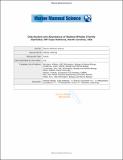Files in this item
Distribution and abundance of beaked whales (Family Ziphiidae) off Cape Hatteras, North Carolina, U.S.A.
Item metadata
| dc.contributor.author | McLellan, William A. | |
| dc.contributor.author | McAlarney, Ryan J. | |
| dc.contributor.author | Cummings, Erin W. | |
| dc.contributor.author | Read, Andrew J. | |
| dc.contributor.author | Paxton, Charles G. M. | |
| dc.contributor.author | Bell, Joel T. | |
| dc.contributor.author | Pabst, D. Ann | |
| dc.date.accessioned | 2019-03-30T00:37:54Z | |
| dc.date.available | 2019-03-30T00:37:54Z | |
| dc.date.issued | 2018-03-30 | |
| dc.identifier | 252145878 | |
| dc.identifier | 545d7225-0416-4632-9b37-4b95a60e657b | |
| dc.identifier | 85044598415 | |
| dc.identifier | 000448183700006 | |
| dc.identifier.citation | McLellan , W A , McAlarney , R J , Cummings , E W , Read , A J , Paxton , C G M , Bell , J T & Pabst , D A 2018 , ' Distribution and abundance of beaked whales (Family Ziphiidae) off Cape Hatteras, North Carolina, U.S.A. ' , Marine Mammal Science , vol. 34 , no. 4 , pp. 997-1017 . https://doi.org/10.1111/mms.12500 | en |
| dc.identifier.issn | 0824-0469 | |
| dc.identifier.other | ORCID: /0000-0002-9350-3197/work/41304414 | |
| dc.identifier.uri | https://hdl.handle.net/10023/17400 | |
| dc.description.abstract | Beaked whales are vulnerable to the impacts of disturbance from several sources of anthropogenic sound. Here we report the distribution and abundance of beaked whales off Cape Hatteras, North Carolina, USA, an area utilized by the U.S. Navy for training exercises, and of particular interest for seismic geophysical surveys. From May 2011 through November 2015, monthly aerial surveys were conducted at the site. Beaked whales were encountered 74 times (n= 205 individuals) during these surveys. Ziphius cavirostris, the most commonly encountered species, was observed in every month of the year. Mesoplodon spp. were encountered in ten months of the year. Photographs of adult males with erupted teeth permitted six sightings to be identified conclusively as M. europaeus; M. mirus was also photographed just outside the study area. Beaked whale surface densities stratified by depth (0.005 – 0.007/km2) were among the highest reported in the world for small ziphiids. A quantitative comparison of sightings and stranding records suggests that strandings do not accurately reflect the relative abundance of beaked whale species in this area. We conclude that Cape Hatteras, at the convergence of the Labrador Current and Gulf Stream, is a particularly important year-round habitat for several species of beaked whales. | |
| dc.format.extent | 2058890 | |
| dc.language.iso | eng | |
| dc.relation.ispartof | Marine Mammal Science | en |
| dc.subject | Beaked whales | en |
| dc.subject | Cape Hatteras | en |
| dc.subject | Ziphius cavirostris | en |
| dc.subject | Mesoplodon-europeus | en |
| dc.subject | Mesplodon mirus | en |
| dc.subject | Densities | en |
| dc.subject | Strandings | en |
| dc.subject | QA Mathematics | en |
| dc.subject | QH301 Biology | en |
| dc.subject | NDAS | en |
| dc.subject.lcc | QA | en |
| dc.subject.lcc | QH301 | en |
| dc.title | Distribution and abundance of beaked whales (Family Ziphiidae) off Cape Hatteras, North Carolina, U.S.A. | en |
| dc.type | Journal article | en |
| dc.contributor.institution | University of St Andrews. School of Mathematics and Statistics | en |
| dc.contributor.institution | University of St Andrews. Scottish Oceans Institute | en |
| dc.contributor.institution | University of St Andrews. St Andrews Sustainability Institute | en |
| dc.contributor.institution | University of St Andrews. Centre for Research into Ecological & Environmental Modelling | en |
| dc.identifier.doi | 10.1111/mms.12500 | |
| dc.description.status | Peer reviewed | en |
| dc.date.embargoedUntil | 2019-03-30 |
This item appears in the following Collection(s)
Items in the St Andrews Research Repository are protected by copyright, with all rights reserved, unless otherwise indicated.

